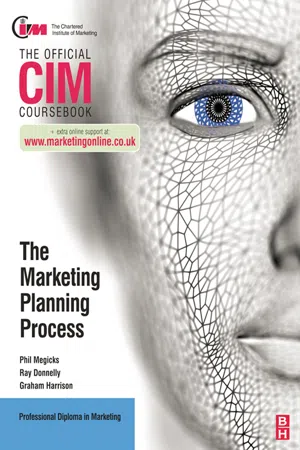Marketing
Marketing Operations
Marketing operations involve the planning, execution, and optimization of marketing activities to achieve business goals. It encompasses processes, technology, and data analysis to streamline marketing efforts, improve efficiency, and drive better results. Marketing operations teams focus on managing resources, implementing best practices, and leveraging technology to support the overall marketing strategy.
Written by Perlego with AI-assistance
Related key terms
1 of 5
4 Key excerpts on "Marketing Operations"
- eBook - PDF
Operations Management
An Integrated Approach
- R. Dan Reid, Nada R. Sanders(Authors)
- 2023(Publication Date)
- Wiley(Publisher)
What is Operations Management? LEARNING OBJECTIVE Define operations management. Every business is managed through three major functions: finance, marketing, and operations management. Figure 1.1 illustrates this by showing that the vice presidents of each of these functions report directly to the president or CEO of the company. Other business functions— such as accounting, purchasing, human resources, and engineering—support these major functions. Finance is the function responsible for managing cash flow, current assets, and capital investments. Marketing is responsible for sales, generating customer demand, and understanding customer wants and needs. Most of us have some idea of what finance and marketing are about, but what does operations management do? Operations management (OM) is the business function that plans, organizes, coordi- nates, and controls the resources needed to produce a company’s goods and services. Oper- ations management is a management function. It involves managing people, equipment, technology, information, and many other resources. Operations management is the central operations management (OM) The business function responsible for planning, coordinating, and controlling the resources needed to produce a company’s goods and services. President or CEO Operations V.P. of Operations Manages: people, equipment, technology, materials, and information To produce: goods and/or services Marketing V.P. of Marketing Manages: customer demands Generates: sales for goods and services Finance V.P. of Finance Manages: cash flow, current assets, and capital investments FIGURE 1.1 Organizational chart showing the three major business functions What is Operations Management? 3 core function of every company. This is true whether the company is large or small, provides a physical good or a service, is for-profit or not-for-profit. Every company has an operations management function. - eBook - ePub
Marketing Management
Text and Cases
- Robert E Stevens, David L Loudon, Bruce Wrenn(Authors)
- 2012(Publication Date)
- Routledge(Publisher)
Chapter 6 Marketing Planning: Operational PerspectivesIn Chapter 5 we learned that marketing managers must first adopt a strategic perspective for marketing planning, then translate that perspective into an operational marketing plan. In this chapter we learn how to do planning at the operational level (see Figure 6.1 ).Figure 6.1. The Effective Marketing Management ProcessThe strategic planning process described in Chapter 5 concentrated on corporate-level and strategic-business-unit planning. These two levels of planning precede development of the strategic marketing plan and the annual operating marketing plan. The strategic marketing plan contains the overall strategic approaches to marketing within a business unit. The annual plan spells out the details of what is to be done on a day-to-day, week-to-week, and month-to-month basis to translate the strategic marketing plan into specific actions, responsibilities, and time schedules.Strategic marketing plans are derived from corporate strategic plans. Although they are more detailed and cover only the marketing function, strategic marketing planning involves steps similar to strategic planning at the corporate level. The steps usually include a detailed analysis of a company’s situation, setting specific objectives, developing strategy, implementing strategy, and evaluating and controlling strategy.The operating marketing plan is a detailed tactical statement explaining what must be done, when, and how. In other words, the strategic marketing plan deals with what is to be accomplished in the long run, while the operating marketing plan deals with what is to be done in a given time period, usually a year.The operating marketing plan focuses on the tactical decisions needed to carry out the strategic marketing plan. The time frame for the operating marketing plan is usually a year and normally coincides with an organization’s fiscal year. The situation analysis deals only with the current operating environment and details only important events that influence changes in marketing activities. The strategy portion contains the detailed tactical decisions that spell out changes in such areas as advertising themes, new products, etc. - eBook - PDF
Operations Management
An Integrated Approach
- R. Dan Reid, Nada R. Sanders(Authors)
- 2020(Publication Date)
- Wiley(Publisher)
Every business is managed through three major functions: finance, marketing, and operations management. Figure 1.1 illustrates this by showing that the vice presidents of each of these functions report directly to the president or CEO of the company. Other business functions— such as accounting, purchasing, human resources, and engineering—support these three major functions. Finance is the function responsible for managing cash flow, current assets, and capital investments. Marketing is responsible for sales, generating customer demand, and understanding customer wants and needs. Most of us have some idea of what finance and marketing are about, but what does operations management do? Operations management (OM) is the business function that plans, organizes, coordi- nates, and controls the resources needed to produce a company’s goods and services. Oper- ations management is a management function. It involves managing people, equipment, technology, information, and many other resources. Operations management is the central core function of every company. This is true whether the company is large or small, provides a physical good or a service, is for-profit or not-for-profit. Every company has an operations management function. Actually, all the other organizational functions are there primarily to support the operations function. Without operations, there would be no goods or services to sell. Consider a retailer such as The Gap, which sells casual apparel. The marketing function provides promotions for the merchandise, and the finance function provides the needed capi- tal. It is the operations function, however, that plans and coordinates all the resources needed to design, produce, and deliver the merchandise to the various retail locations. Without oper- ations, there would be no goods or services to sell to customers. The role of operations management is to transform a company’s inputs into the fin- ished goods or services. - eBook - ePub
- Ray Donnelly, Graham Harrison, Phil Megicks(Authors)
- 2010(Publication Date)
- Routledge(Publisher)
Marketing is the management process responsible for identifying, anticipating and satisfying customer requirements profitably. (Chartered Institute of Marketing)According to Dibb et al. (2006 ) ‘Marketing consists of individual and organisational activities that facilitate and expedite satisfying exchange relationships in a dynamic environment through the creation, distribution, promotion and pricing of goods, services and ideas’.McDonald (2007 ) agrees there is considerable confusion about what marketing is.He suggests that marketing is the process for:- defining markets
- quantifying the needs of the customer groups (segments) within these markets
- determining the value proposition to meet these needs
- communicating these value propositions to all those people in the organisation responsible for delivering them, and getting their buy-in to their role
- playing an appropriate part in delivering these value propositions (usually only communications)
- monitoring the value actually delivered
The marketing function is concerned with the management of the marketing mix, involving the various tools and techniques available to marketing managers. The marketing mix being, product, price, promotion and place (the four P’s). Increasingly, the mix includes additional elements: people, physical evidence and processes (the extended services mix or seven P’s). Depending on the organisation it can also involve the integrated planning of marketing together with any research that is undertaken into markets, customers, competitors, or on initiatives such as new products.Marketing as a stand-alone function appears to have been transformed, replaced in an increasing numbers of organisations with marketing as a philosophy, i.e. a way of doing business that focuses on the customer. This could include sales, customer service, customer relationship management and customer intelligence, for example. Increasingly, a marketing orientation is seen as critical to the success of organisations, as it drives the organization towards its goals through delivering value to customers.
Index pages curate the most relevant extracts from our library of academic textbooks. They’ve been created using an in-house natural language model (NLM), each adding context and meaning to key research topics.



